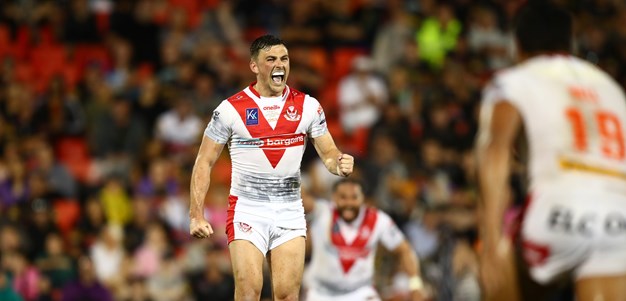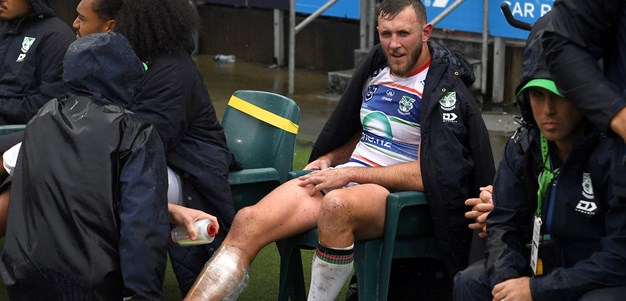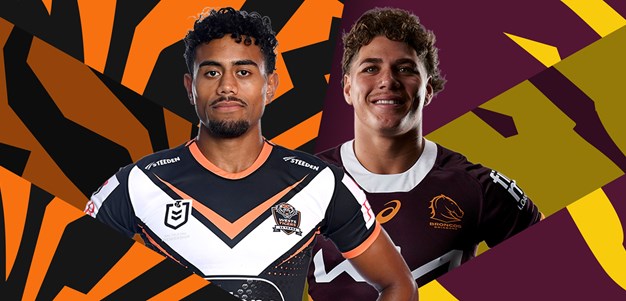Brisbane enter the 2023 Telstra Premiership Grand Final as the most exciting attacking team in the NRL with a host of deadly dangerous options available at their disposal.
Adam Reynolds and Ezra Mam have struck a wonderful combination of consistency, deception and flare. Payne Haas and Patrick Carrigan are dominating in the middle; Herbie Farnworth, Kotoni Staggs and Selwyn Cobbo are constant attacking threats on the edge all the way up the field.
But the icing on the cake is Reece Walsh. He's the tip of the spear. The feather in their cap for the attack to average 27.2 points per game this season.
The best fullback in the game this year, Walsh more than doubled his career try assist tally to have 25 in 21 games in 2023. His 153 running metres per game and 19 line breaks for the season are both new career highs.
He’s fearless with the ball. Only four minutes after throwing an intercept try in the Preliminary Final, he was throwing a try assist on a similar shape.
Walsh is a wizard
No player has made more errors than Walsh’s 50 this season, but the 21-year-old is a goldfish. He quickly wipes the error from his memory and starts putting himself in positions to throw another pass at speed out wide.
We know what Walsh is at this point. We’ve seen it all season for the Broncos and Queensland Maroons. Where some playmakers might pull back on such a big occasion, there is no risk of Walsh providing anything other than his ruthless attack-first approach to his opportunities with the ball.
So, how do you stop him?
It’s a process and one few teams have been able to master across 80 minutes.
Walsh has only finished two games all season without a try or try assist: Round 9 v Rabbitohs and Round 17 v Titans. The Panthers did, however, keep a Reynolds-less Broncos to a season-low four points in their last meeting back in Round 12.
“The more you can win around the ruck and hopefully win the field position battle, it certainly helps because he’s not attacking your try line as much so that will certainly be a part of it,” Panthers captain Isaah Yeo said earlier this week.
Field position will obviously help Penrith’s case, but Brisbane has proven capable of scoring from anywhere all year. It’s the winning around the ruck and how much easier that makes things for the defence on the edges that is the key.
It starts with the stick in the tackle, the wrestle to the ground and slowing the play-the-ball. Ideally for coach Kevin Walters, Walsh adds pace behind an already fast play-the-ball – of which Payne Haas is arguably the best in the business.
Haas has played the ball leading to a try 20 times in 22 games this season. Fittingly, Penrith’s Moses Leota provides the context to be second with 15 in 25.
Haas is in a league of his own when it comes to acting as the trigger to a scoring action. He’s a massive unit that attracts 2.5 players to the tackle before points with a lightning-quick 3.01-second play-the-ball, often beating defenders to their spot.
His intention is to scramble the line and put pressure on the fullback to organise it efficiently and effectively. Better yet, if Haas can leave a defender on the ground behind the ruck, he takes a number out of the line entirely.
Reece Walsh sets up Cobbo try
A line late to set creates opportunities on the edges, with this one of many examples throughout the season.
Haas attracts three to the tackle but you can see by how quickly Jacob Saifiti gets out of the tackle that this action is one the Newcastle Knights have anticipated.
Rather than adding his weight and giving Tyson Frizell enough time to retreat or get to marker, he jumps off and sets himself around the ruck. That’s all Haas needs to generate the shift-defining play-the-ball. His play-the-ball beats Frizell to marker, forcing Saifiti to hold onto Billy Walters at dummy half as the Carrigan lead ties up Phoenix Crossland and, only for a step, Dylan Lucas.
That’s enough for Reynolds to put Walsh outside Tyson Gamble and it ends like many other shifts this season, with Cobbo over in the corner.
A split-second in the middle is all it can take for Walsh to get on the outside of the three-in defender. From there, his speed and pass selection is the most dangerous combination in the competition and near impossible to defend against.
If the defence gets the tackle right and forces a slower play-the-ball, they still need to organise the line and move together, at speed, off the line. It’s crucial for the edges to move up and across together and for the middle to work hard from the inside to close down the time and space Reynolds, Mam and Carrigan have.
The Storm do it all in the middle here. Josh King stays in the tackle over the top and gives Nick Meaney enough time to send Harry Grant to the long side where he knows Walsh is setting up for another attacking raid.
Jordan Riki Try
Now with an extra man to what the Knights had available, Christian Welch charges at Reynolds without slowing his feet. Still, with Trent Loiero unable to put Carrigan on his inside, Cameron Munster motions in for just one step – that’s all it takes for a sweeping Walsh to create the overlap he’s after and send Jordan Riki through.
One step out of time and Walsh has the speed to make the most of it.
Edge defences are constantly double-defending as lead runners attack the inside shoulder while a sweeping runner floats to the outside around the back. The earlier the ball player is forced to pass the ball, the more time edge defenders have to make their decision and release from the lead runner.
Miss the jump on Walsh while waiting for those inside to bounce out and his incredible acceleration does the rest.
Reynolds named Dally M Captain of the Year
There are a lot of examples of Reynolds simply shovelling the ball on, too. Such is the speed they have on the edges, digging into the line and engaging defenders himself often isn’t the be-all and end-all of a Broncos shift. In fact, he’s averaging 7.2 line engagements per game this season after averaging 8.3 per game in 2022.
Nonetheless, taking the time away from Reynolds, Mam and Carrigan makes things slightly easier for the defending edges. And the Panthers are set up well to take that early pass away from Reynolds.
Penrith dominated in yardage when the two sides met back in Round 12. They won possession and territory, as Yeo mentioned earlier, and limited Walsh’s opportunities to attack. When Walsh did manage to take possession in a threatening position following a strong carry and slow-peeling defender, Nathan Cleary and Jarome Luai jammed and forced him into quick decisions.
Panthers defensive set
While other teams have adopted an approach to jamming on him, Penrith’s defensive systems put them in a position to do so effectively. They get high on the edges and Luai, in particular, will look to spoil a shift by shooting out of the line early.
With the line speed of their edges and the likes of Yeo, Liam Martin and James Fisher-Harris working from the inside, the Panthers are able to take the risk of jamming in while trusting those inside will scramble and clean up any mistakes.
Interestingly, Walsh’s 43 touches in that Round 12 match ended up as his most in a game all season. And therein lies the key to stopping him.
It’s not the number of touches but the quality you provide.
Running downhill and playing at speed is where Walsh excels.
He’s only able to do that when the Broncos are able to generate a quick play-the-ball and run at a retreating or stagnant defensive line.
Winning the ruck and dominating in the middle stops Walsh on the edges and will be where the game is won and lost on Sunday.
Match: Panthers v Broncos
Grand Final -
home Team
Panthers
1st Position
away Team
Broncos
2nd Position
Venue: Accor Stadium, Sydney




